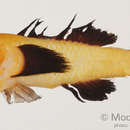ar
الأسماء في صفحات التنقل


True gobies were a subfamily, the Gobiinae, of the goby family Gobiidae, although the 5th edition of the Fishes of the World does not subdivide the Gobiidae into subfamilies.[1] They are found in all oceans and a few rivers and lakes, but most live in warm waters. Altogether, the Gobiinae unite about 1149 described species in 160 genera, and new ones are still being discovered in numbers.
They are usually mid-sized to small ray-finned fishes; some are very colorful, while others are cryptic. Most true gobies are less than 10 cm (4 in) long when fully grown. The largest species Glossogobius giuris can reach up to 50 cm (20 in); the smallest known species as of 2010, Trimmatom nanus, is just about 1 cm in length when fully grown, making it one of the smallest vertebrates.
In many true gobies, the pelvic fins have grown together into a suction cup they can use to hold on to substrate. Most have two dorsal fins, the first made up from spiny fin rays, while the other has some spines in the front followed by numerous soft rays.
They are most plentiful in the tropical and subtropical regions, but as a group are almost cosmopolitan in marine ecosystems. A few species tolerate brackish water, and some – Padogobius and Pomatoschistus species – even inhabit fresh water. They are generally benthic as adults (the spawn can distribute widely by ocean currents), only Sufflogobius bibarbatus is noted to be quite pelagic throughout its life. Most inhabit some sort of burrow or crevice and are somewhat territorial. In some cases, they live in symbioses with unrelated animals, such as crustaceans.
The larger species are fished for food, in some cases on a commercial scale. Many Gobiinae species are popular aquarium fish. Especially popular are the colorful species, some of which are regularly traded. In general, the interesting behavior and bold habits make most true gobies seem attractive pets. However, their territoriality and because even the smallest species are fundamentally carnivorous and need living food to thrive make them not easy to keep (particularly compared to the related family Eleotridae). As typical for oceanic fishes, many Gobiinae tend to be almost impossible to breed in captivity, and some species have become rare from habitat destruction and overfishing.
This subfamily contains about 160 genera and 1120 species:[2]

True gobies were a subfamily, the Gobiinae, of the goby family Gobiidae, although the 5th edition of the Fishes of the World does not subdivide the Gobiidae into subfamilies. They are found in all oceans and a few rivers and lakes, but most live in warm waters. Altogether, the Gobiinae unite about 1149 described species in 160 genera, and new ones are still being discovered in numbers.
Gobiinae Gobiidae familiako arrain azpifailia bat da. Ozeano guztietan eta erreka eta laku batzuetan bizi dira, baina gehienak ur epeletan bizi dira. Guztira 160 genero eta 1149 espezie ezagutzen ditugu.
Gobiinae Gobiidae familiako arrain azpifailia bat da. Ozeano guztietan eta erreka eta laku batzuetan bizi dira, baina gehienak ur epeletan bizi dira. Guztira 160 genero eta 1149 espezie ezagutzen ditugu.
Gobiinae on tokkojen heimoon (Gobiidae) kuuluva kalojen alaheimo.
Alaheimoon kuuluu 166 sukua ja 1085 lajia. [1]
Gobiinae on tokkojen heimoon (Gobiidae) kuuluva kalojen alaheimo.
Gobiinae er en stor gruppe kutlinger med omtrent 1950 arter. Det finnes over hele verden, men har størst utbredelse i tropiske og subtropiske områder.
De fleste artene er ganske små, vanligvis under 10 cm lange, men enkelte arter som Glossogobius giuris kan bli opptil 50 cm. Noen av verdens minste fiskearter hører til delgruppen Trimmatom. Hos mange arter er bukfinnene vokst sammen til en sugeskål som de kan bruke til å holde seg fast med. Første ryggfinne, hvis den fins, består kun av piggstråler, mens den andre har både piggstråler og bløtstråler.
De 12 artene av kutlinger som finnes i Norge hører alle til gruppen Gobiinae.
Gobiinae er en stor gruppe kutlinger med omtrent 1950 arter. Det finnes over hele verden, men har størst utbredelse i tropiske og subtropiske områder.
Gobiinae, hay còn gọi là cá bống thực sự, là một phân họ của họ Gobiidae.
Gobiinae, hay còn gọi là cá bống thực sự, là một phân họ của họ Gobiidae.
Gobiinae Cuvier, 1816
Gobiinae (лат.) — подсемейство рыб из семейства бычковых (Gobiidae). Включает почти 2000 видов в 149 родах.
Подсемейство Gobiinae является космополитом. Большинство видов — хищники, некоторые едят водоросли. В основном территориальные животные, некоторые — колониальные. Большинство видов в длину менее 10 см, в том числе обитающий в Индо-Тихоокеанской области Trimmatom nanus, до 2004 года считавшийся самым мелким видом рыб[1], — не более 10 мм в длину; Glossogobius giuris может быть до 50 см. В основном донные животные; Sufflogobius bibarbatus — пелагический вид. У многих видов брюшные плавники срослись в присоску. Некоторые виды образуют симбиоз с роющими креветками. Elacatinus — животные-чистильщики. Многие виды популярны в качестве аквариумных животных. Как правило, не размножаются в неволе, а некоторые виды стали редкими из-за разрушения среды обитания и чрезмерного вылова.
Gobiinae (лат.) — подсемейство рыб из семейства бычковых (Gobiidae). Включает почти 2000 видов в 149 родах.
Подсемейство Gobiinae является космополитом. Большинство видов — хищники, некоторые едят водоросли. В основном территориальные животные, некоторые — колониальные. Большинство видов в длину менее 10 см, в том числе обитающий в Индо-Тихоокеанской области Trimmatom nanus, до 2004 года считавшийся самым мелким видом рыб, — не более 10 мм в длину; Glossogobius giuris может быть до 50 см. В основном донные животные; Sufflogobius bibarbatus — пелагический вид. У многих видов брюшные плавники срослись в присоску. Некоторые виды образуют симбиоз с роющими креветками. Elacatinus — животные-чистильщики. Многие виды популярны в качестве аквариумных животных. Как правило, не размножаются в неволе, а некоторые виды стали редкими из-за разрушения среды обитания и чрезмерного вылова.